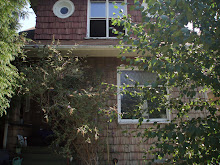An hour south of Tucson, the remains of the same storm are taking their time, seeping through the limestone, exposing traces of iron. It's a theory anyway; underground, precious drops of water build conulites on the driest days of desert summer. Some hundreds of thousands of years ago a geological shift rocked the hills from their foundation, creating underground craters. Reservoirs that feed the caves.
In 1974, a couple of young, trespassing, cavers found a sinkhole at the base of the Whetstone Mountains. Belly crawling through a one-foot opening, they smelled success. A scent so powerful, Gary Tenen and Randy Tufts knew they were on to something. Only a cavern of significant size, with at least moderate air-flow, could house a bat colony capable of such a stench. After four years of exploration and mapping, the two approached the property owners with news of their find.
At the park gate, again at the discovery center and before boarding the tram, the Kartchner staff ran us through the long list of "no's":
foods, drinks, tobacco, gum, bags, sun glasses, jackets tired around waists, backpacks, strollers, binoculars, crutches...
Our ranger tried to soften the "don'ts" with humor, but a cave enterence complete with 4 air-locked steel doors, paints a clear picture. Pristine caves are a rare find; the rangers and researchers are not fooling around. I want to pet the shelfstones and wonder, would a soda straws break with just a flick of the finger? He describes the moonmilk as "tacky, like cream cheese" and I'm tempted to squeeze it through my fingers. A series of half-domes form "popcorn" on the ceiling and "fried eggs" stalagmites rise from the floor. Not long after breakfast, and far from hungry, I'm curious what a small grain of coral pipe might taste like. Well intentioned and semi-sensible, I am, with my inquisitive nature and greasy fingerprints, the reason Tenen and Tufts kept discovery of the cave hushed for 14 years.
It's a sensory experience; the impenetrable black of the "research-only" tunnels , condensation at 95% wraps my skin, the still of earth's hollows in my ears. Photos are off limits, a sudden flash could potentially startle a visitor who could lose her balance and reach to steady herself on a drapery. The cave might recover, in 100,000 years. Our elbows and eye lashes, finger prints and clothes lint are hazards. Above a mound of 45,000 year old guano, the cave ceiling is scratched, darkened. No canopy or coralloids. The bats gave up this roost 40,000 years before the birth of Buddha, Muhammad or Jesus, and cave-life has yet to recover.
Under that rough exterior, below the the desert landscape's thorns and needles, it's seems a very fragile earth.

2 comments:
I always enjoy reading your Blog Nora. I like the websites that you post. Here is a speech by John Walcott from Bill Moyers website. Tom
Hi Tom, thanks for letting me know you're checkin' in with us!
I edited your comment to link to the Walcott piece. Whew. Media consolidation has not served journalism well. Walcott shines much needed light on the failings and lies that led us into war. I'd like to see this speech get more press. Maybe I'll start quoting it...
Post a Comment